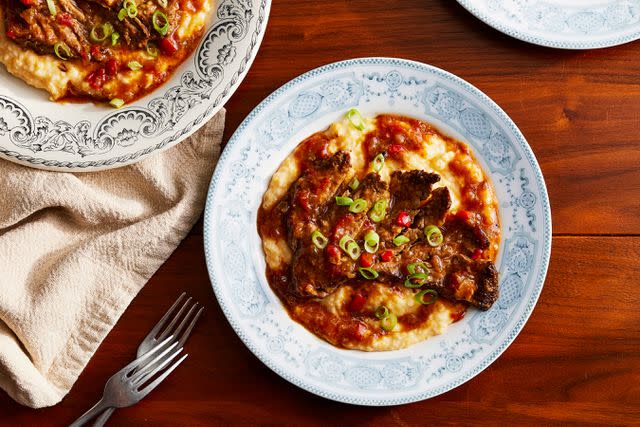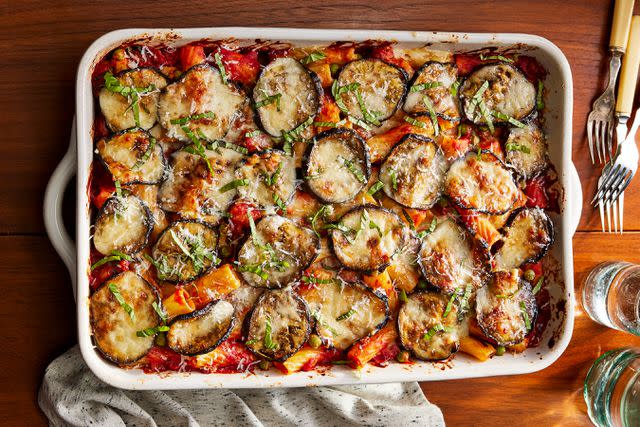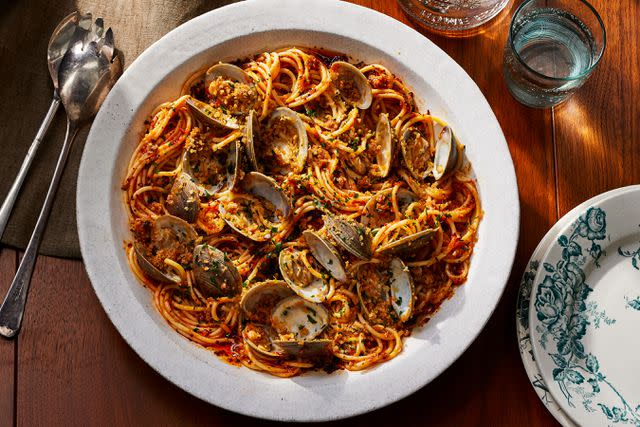My Kids Are on the Spectrum — Here's What I Learned From Cooking With Them
We grew to understand each other over pasta dough and French toast.

Rush Jagoe
Once upon a time, my cooking was entirely focused on creating black-eyed pea curry bowls, NOLA hot sausage po’ mi sandwiches, crawfish tom yum tossed with housemade gnocchetti, and other Southeast Asian–inspired dishes at my New Orleans restaurants, Maypop and MOPHO. After years of working my way up in fine-dining kitchens, I was finally achieving my dream of cooking food I loved in my own restaurants and garnering awards for my work. But then I started cooking at home with my twin sons, Ethan and Liam, and my cooking life split in half.
Ethan and Liam have autism spectrum disorder. This means that they are neuroatypical and process information and stimuli differently than most people. Autism is called a spectrum because everyone on that spectrum manifests the disorder differently. My boys are what’s called high-functioning. They are verbal (sometimes more than I’d like), have strong motor skills, perceive life in a logical and concrete manner, remain puzzled by the actions of most “normal” people, and feel compelled to call out the apparent insanity happening in the world around them. On top of all this, they are severely dyslexic. It wasn’t until after months of tutoring that they could read street signs. The first time I heard them reading random words and sentences aloud, it broke my heart, as I realized that for the first five years of their lives, they hadn’t been able to register the stream of information flowing around them.
My sons were diagnosed with autism when they were three years old. That was the year I opened my first restaurant. It was a hard time; their mother and I had split up, and I was working around the clock. The hardest truth for me to acknowledge about that time is that I only saw them once a week.
Most of the time, my mother and stepfather took care of my sons. Just as they did with me when I was a kid, they got the boys helping with breakfast on Saturday mornings, preparing the salad for dinner, or making cookies. While I pulled long hours at the restaurant, my mother sent me videos of Ethan and Liam standing on a chair pouring pancake batter into a cast-iron pan or making the egg-and-milk royale for French toast. I saw how much they loved cooking, and how proud they were of themselves. On my days off, they always asked if we could cook together.
It wasn’t enough to roll the pasta; they pushed to make the dough, too.
When the pandemic shut everything down, I couldn’t cook in my restaurants, and we started to spend more time together in the kitchen at home, making family recipes like grillades and grits. At first, I tried to keep it simple, but it wasn’t enough to roll the pasta; they pushed to make the dough, too. I saw how working with their hands calmed their regularly overstimulated minds. In these days of iPads and social media, attention spans are sheared critically short. But while making fresh pasta, they stayed fixated on the steps, rounding out a well in the center of a pile of flour, cracking eggs into it, drizzling in olive oil, then slowly working the dough into a smooth ball. They scrutinized every texture and aroma, pulling everything in close and inhaling deeply. They ran their hands over the ingredients, popping different foods in their mouths, describing the sensations and flavors to me.
These days, we’re still at it. We share an apartment, and kitchen space is tight. When all three of us try to cook together, it’s a mildly chaotic game of bumper cars. Add middle school homework to the mix, and, all too often, I’m tempted to just knock out dinner as quickly as possible. But they still want to cook. If I suggest meatloaf, they immediately make a mixture of milk, eggs, and torn bread in a bowl, chop up an onion, sweat it in oil, and add it to the bowl with salt and pepper. They fold in the ground pork and beef by hand until it’s a perfect, shiny mass. They do it all themselves, and it tastes astonishingly good. We go visit my aunt Amy-May and cook with her as she shares my family recipes for pasta ’ncasciata and her famous stuffed shells. She helps us connect to the food we eat, not just with the process of making it but also the heart that goes into it.
Of course, they’ve asked about cooking with me in my restaurants. To some extent, it makes sense; a few cooks at the restaurants have told me they are also dyslexic, and I see how the structure of prepping and cooking works well with their brains. Cooking forces the boys to read and digest recipes, organize their ingredients, and do fractions and conversions for their measurements. But while they are champs at peeling garlic, ginger, and shallots, they still get overloaded from a sensory standpoint. That can be dangerous in a professional kitchen if they aren’t paying attention to their surroundings.
So we cook at home, even if sometimes, their confidence goes too far. I’ve woken up on many weekend mornings to a smoke-filled apartment, my boys chowing down on pancakes that are charred on the outside and raw on the inside. Every kitchen surface is sticky, greasy, or some impossible mixture of both. If this happened at my restaurants, I would turn into the stern chef. But at home, I’m the chef and the dad. “Boys, what did we do wrong here?” They respond in unison: “We got our pan too hot.” They roll their eyes, like any cooks getting lectured. But they understand why. When I told them I was writing about them, Ethan worried that people would bother him about it. But like any young cook, Liam told me that the best food is made with love.
Grillades and Cheesy Grits

Fred Hardy II / Food Styling by Emily Nabors Hall / Prop Styling by Christina Daley
A simple low and slow cooking technique transforms beef top round into the ultimate New Orleans comfort dish.
Pasta ’Ncasciata (Sicilian Baked Pasta)

Fred Hardy II / Food Styling by Emily Nabors Hall / Prop Styling by Christina Daley
This hearty baked pasta dish is packed with tender eggplant, melty caciocavallo cheese, and crushed tomato sauce.
Spaghetti with Clams and NOLA Hot Sausage

Fred Hardy II / Food Styling by Emily Nabors Hall / Prop Styling by Christina Daley
A final garnish of crunchy lemon panko topping adds a delightful contrast in texture to al dente spaghetti, spicy sausage, and chewy clams in this classic recipe.

